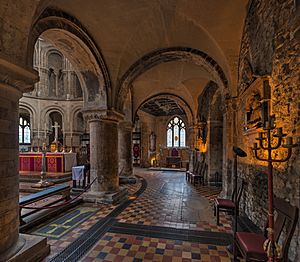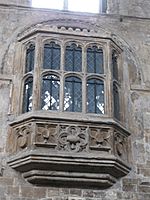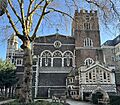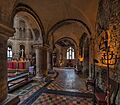St Bartholomew-the-Great facts for kids
Quick facts for kids St Bartholomew the Great |
|
|---|---|
| Priory Church of St Bartholomew the Great |
|
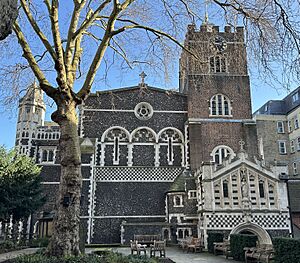
West front
|
|
| Location | London, EC1 |
| Country | United Kingdom |
| Denomination | Church of England |
| Previous denomination | Roman Catholicism |
| Tradition | Anglo-Catholic |
| Website | greatstbarts.com |
| History | |
| Founded | 1123 |
| Founder(s) | Rahere |
| Architecture | |
| Heritage designation | Grade I listed building |
| Style | Norman |
| Administration | |
| Parish | Great St Bartholomew |
| Diocese | London |
| Province | Canterbury |
The Priory Church of St Bartholomew the Great, often called St-Barts-the-Great, is a very old church in London. It belongs to the Church of England and is located in an area called Smithfield. This amazing building started as an Augustinian priory in 1123. A priory is like a monastery, a place where monks or canons live and pray. The church is right next to St Bartholomew's Hospital, which was founded at the same time.
St Bartholomew the Great got its name to tell it apart from a smaller church nearby, St Bartholomew the Less. That smaller church was also founded at the same time, inside the hospital grounds. In 2012, these two churches joined together. Today, both buildings are used for church services and are home to a lively community.
Contents
History of the Church
How the Medieval Priory Began
The church was started in 1123 by a man named Rahere. He was a religious leader at Old St Paul's Cathedral. Rahere had a dream while he was visiting the Vatican. In his dream, a winged creature told him to build a church in London's Smithfield area.
When Rahere returned to London, he found out that the land from his dream was royal property. This meant he couldn't build on it without permission. However, King Henry I heard Rahere's story about the dream. The King was so impressed that he gave Rahere the land.
Rahere began building the church with the help of workers, including children. They gathered stones from all over London to construct the new priory.
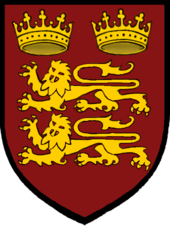
The priory became famous for its healing powers. Many sick people came to its aisles, especially on August 24th, which is St Bartholomew's Day. People believed that many miracles happened there, including amazing healings. Many serious illnesses were said to be cured after a visit. A lot of these cures took place at the church's hospital, which is still known as St Bartholomew's Hospital.
The Dissolution and Changes
The last leader of the Priory was Robert Fuller. He was also the Abbot of Waltham Holy Cross. King Henry VIII liked him, and Robert Fuller did not try to stop the King from closing down the priory.
During the time known as the Dissolution of the Monasteries, many religious buildings were closed. About half of St Bartholomew's Priory church was damaged and then torn down in 1543. Even though it survived the Great Fire of London in 1666, the remaining parts of the church fell into disrepair.
Later, during the time of Canon Edwin Sidney Savage, the church was repaired even more. The parts of the church that survived included the tall arches where the main parts of the church met, and the choir area. These parts are still largely from the Norman period and the Middle Ages. This allowed the building to continue being used as a church.
For a short time, from 1556 to 1559, the church and some of its other buildings were used by Dominican friars. The main entrance to the church can still be seen today at West Smithfield. It has a unique half-timbered front from the late 1500s, built on an older stone arch from the 1200s.
Later Years and Famous Visitors
In the early 1720s, the famous American inventor and writer Benjamin Franklin worked as a typesetter in a printing shop. This shop was located in what is now part of the Church of St Bartholomew-the-Great.
The Lady chapel, which is at the east end of the church, was used for businesses after the priory was closed. It was divided into workshops and houses. This is where Benjamin Franklin worked as a printer for a year. The north transept (a part of the church that sticks out) was even used as a blacksmith's forge! Some parts of the church site were also lived in by people without permission in the 1700s.
In 1888, new school rooms for the parish were built on what used to be burial grounds. These rooms also had basement areas for youth clubs and a soup kitchen. The Duchess of Albany laid the foundation stone for these new buildings.
Restoring the Church
Starting in 1889, the church underwent a lot of restoration work. This was led by the architect Sir Aston Webb. During this time, the Lady Chapel and the south transept were repaired. A new north transept was also built. The west end of the church, where the main part of the church used to be, was given a new front.
The restored south transept was opened in 1891. The north transept was opened in 1893, with important people like the Prince and Princess of Wales attending. The Priory Church was one of the few churches in London that was not badly damaged during the Blitz in World War II.

A special tradition continues in the churchyard on Good Friday. It started when money was left to provide an annual gift to 21 widows. Today, hot cross buns are given out not only to widows but to others as well.
The Priory Church was officially named a Grade I listed building in 1950. This means it's a very important historical building. In 2007, it became the first Anglican church to charge tourists to enter, but this was later stopped. Now, the church is open for free on weekdays.
The United Benefice
For some years, the leader of St Bartholomew the Great church also looked after the nearby St Bartholomew the Less. However, each church still had its own council. On June 1, 2015, the two churches officially joined together. The leader of St Bartholomew the Great became the leader of the new combined church area. Now, one council and churchwardens are in charge of both buildings. St Bartholomew the Great is the main church, and St Bartholomew the Less is used for special services, especially for patients and staff at the hospital.
Special Features of the Church
The Clock Tower
The brick clock tower was built in 1628 on the southwest side of the church. It has a small wooden top and holds older bells that were made between 1500 and 1514.
Rahere's Monument
Just north of the main altar is a monument to the church's founder, Rahere. It is built in a mix of old Gothic styles. A painted statue of Rahere lies on top of the tomb under a fancy canopy. It's not clear if Rahere's actual remains are there, because the monument was built about 250 years after he died in 1144.
The Oriel Window
The special Oriel Window inside the church was put in during the early 1500s by Prior William Bolton. People say he had it installed so he could watch the monks from his living area, which was next to the south side of the church. In the middle of the window, there's a symbol: a crossbow "bolt" going through a "tun" (which is a barrel). This is a rebus, a kind of puzzle or pun on the prior's name, Bolton.
The Lady Chapel
The Lady Chapel, which is at the east end of the church, was said to be "newly built" in 1336. It has a crypt (an underground room) beneath its east end. After the priory was closed, this building was used for businesses and was divided into workshops and houses. The church got it back in the late 1800s, and it was restored to look much like it did originally.
Old Monastic Buildings
Not many parts of the old monastic buildings are still standing above ground today. Three parts of the old cloister (a covered walkway) from the 1400s were restored in the 1920s as a war memorial. The shape of the cloister courtyard was remade as a grassy area when nearby buildings were redeveloped in 2019. The area where the monastery used to be is now marked by the modern streets of Bartholomew Close and Cloth Fair.
The main churchyard area is now a raised garden on Cloth Fair. It was designed in 1885.
Groups Connected to the Church
St Bartholomew the Great is the special church for several City livery companies. These are old trade groups in London. They hold services there throughout the year. Some of these include the Butchers, Founders, Haberdashers, Fletchers, Farriers, and Farmers. More recent groups connected to the church are the Information Technologists, Hackney Carriage Drivers, Tax Advisers, and Public Relations Practitioners.
The Priory Church was also the chapel for the Imperial Society of Knights Bachelor until 2005, when they got their own chapel in St Paul's Cathedral.
In Movies, TV, and Music
The church has been a filming location for many movies and TV shows. It was used for a wedding scene in the film Four Weddings and a Funeral (1994). Other films include Robin Hood: Prince of Thieves, Shakespeare in Love, The End of the Affair (1999), Amazing Grace (2006), Elizabeth: The Golden Age (2007), The Other Boleyn Girl (2008), Sherlock Holmes (2009), Richard II from The Hollow Crown (2012), Snow White and the Huntsman (2012), Testament of Youth (2014), Avengers: Age of Ultron (2015), and Transformers: The Last Knight (2017). It was also seen in the TV series Taboo.
The church was even used by T-Mobile for an advertisement in 2011, pretending to be Westminster Abbey for a "royal wedding" ad. The singing group Libera has filmed six music videos there.
The BBC Radio 3 program Choral Evensong has broadcast live from the church. In 2023, a special service was held there to celebrate the church's 900th anniversary.
Since 2021, the main church services are also streamed live on the parish YouTube channel. These videos stay online for two months.
Music at the Church
The Organ

St Bartholomew the Great has had several organs over the years. An organ was first installed in 1715. The current organ was put in in 1886, coming from another church. It has been changed and updated several times since then. Currently, the church uses a digital organ for services while they plan for a new one.
Choirs
The Priory Church Choir is special because it is made up of professional singers. They are led by Rupert Gough. There is also a choir of amateur singers called the Rahere Singers, who sing for some services.
Notable People and Burials
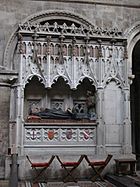
Many important people are buried or have monuments here, including:
- Francis Anthony
- Sir George Hastings
- John Hovyngham
- Sir Rice Mansel
- Sir Walter Mildmay
- Prior Rahere (the founder)
Other Famous Connections
- Sir John Betjeman, a famous poet, lived near the church and thought it had the best Norman interior in London.
- The 11th Duke of Devonshire and Deborah Mitford were married here in 1941 during World War II.
- W. G. Grace, a famous cricketer, was a member of the church.
- William Hogarth, a well-known artist, was baptized here.
- In 2005, a memorial service was held for Sir William Wallace on the 700th anniversary of his execution in nearby Smithfield.
Folklore and Legends
The ghost of Rahere, the church's founder, is said to haunt the church. This story began after his tomb was opened during repair work in the 1800s, and a sandal was taken from it. The sandal was returned, but Rahere's foot was not. Since then, people say a "shadowy, hooded figure" appears, walks past people, and then slowly disappears. Rahere is supposedly seen every year on July 1st at 7 AM, coming out of the Vestry (a room in the church).
Images for kids
See also
 In Spanish: Iglesia de San Bartolomé el Grande para niños
In Spanish: Iglesia de San Bartolomé el Grande para niños
- Sir John Deane's College
- St Bartholomew the Less Church
- List of churches and cathedrals of London
- List of English abbeys, priories and friaries serving as parish churches



